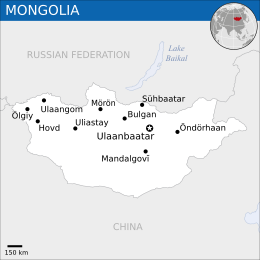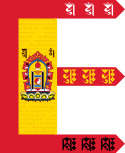More languages
More actions
| Bogd Khanate of Mongolia ᠪᠣᠭᠳᠠ ᠬᠠᠭᠠᠨᠲᠤ ᠮᠣᠩᠭᠣᠯ ᠤᠯᠤᠰ Богд хаант Монгол Улс | |
|---|---|
| 1911–1924 | |
 | |
| Capital | Niislel Khüree |
| Common languages | Mongolian |
| Religion | Buddhism |
| Dominant mode of production | Feudalism |
| Government | Theocratic monarchy |
• Khan | Bogd Khan |
The Bogd Khanate of Mongolia was a theocratic feudal state that existed between the 1911 national liberation revolution and the 1921 socialist revolution in Mongolia. After the revolution, the Bogd Khan remained in place as a figurehead until the founding of the People's Republic in 1924.[1]:300
History[edit | edit source]
Background[edit | edit source]
Following the 1904–5 Russo-Japanese War, Inner Mongolia fell under Japan's sphere of influence while Outer Mongolia fell under Russia's influence. The Russian Empire sought to control Mongolia in order to gain an advantage against imperialist Japan. Between 1891 and 1908, Russian exports to Mongolia increased by 22% while Mongolian exports to Russia increased by 566%.[2]:232–3
In early 1911, Colonel Tan from the declining Qing dynasty arrived in Mongolia and ordered barracks to be built in Örgöö (now Ulaanbaatar). The Mongol nobility held a secret meeting in July planning to break away from the Qing and notified the Russian ambassador to Mongolia. In October, the collapsing Qing agreed not to do any reforms in Outer Mongolia without Russian approval.[2]:234–7
1911 revolution[edit | edit source]
Mongolia declared independence on 1911 December 1, and the Chinese garrison returned to China under the protection of Russian Cossacks. The Qing official in Khovd sealed himself inside a fort with many soldiers and supplies and requested reinforcements from Xinjiang, which Russia prevented from arriving. On 1912 August 6, the peasants stormed the fortress and destroyed debt records. After the Qing was overthrown, the feudal nobility led by the Bogd Khan took power. Yuan Shikai, the new ruler of China, refused to recognize Mongolia's independence.[2]:237–40
While the revolution freed the peasants (arat) from debt held by Chinese usurers and prevented them from having to fund the Qing garrison, it did not weaken the exploitation by the domestic nobility.[2]:253
Establishment of foreign relations[edit | edit source]
In 1912 November, Russia signed a treaty with Mongolia giving Russian capitalists unlimited rights to trade and travel in Mongolia with no tariffs. The Bogd Khan sent Tserenchimed to Japan and requested a Japanese protectorate over Mongolia, which Japan refused in order to avoid angering Russia. In 1913 February, Mongolia formed a brigade of the Russian army with 1,900 soldiers. Mongolia tried to establish diplomatic relations with other imperialist countries but failed. Yuan Shikai's forces attacked Mongolia in early 1913 and made peace in November, recognizing Mongolia as autonomous but not fully independent. The Bogd Khan withdrew his troops from Inner Mongolia in 1913, and Russia withdrew its troops from Outer Mongolia in 1914.[2]:240–7
The secular nobility generally favored Russia while the lamas, who formed the Bogd Khan's inner circle, favored Japan. The lamas poisoned the pro-Russian prime minister and foreign minister.[2]:253
Russia stopped exporting to Mongolia during the First World War, and the 1915 Hiagt Agreement allowed Chinese merchants to return to Mongolia.[2]:258
Russian and Chinese invasions[edit | edit source]
In 1917, peasants in the provinces of Tsetsen Khan and Tushetu Khan protested against feudalism and foreign imperialism but did not achieve anything.[1]:271
In late 1917, fighting broke out near the northern border of Mongolia between workers and peasants and invading Whites and local feudal lords. In early 1918, the capitalists, landlords, kulaks, and Whiteguards who had been overthrown in Russia began fleeing into Mongolia, making the peasants desire a revolution in their own country. When the Whites took control of Siberia in late 1918, Soviet workers and peasants fled to Mongolia. The Bogd Khan allied with the pro-Japanese Anhui clique of Chinese warlords, who invaded Mongolia in 1918. In mid-1919, after retaking the East, the Soviet government abolished all unequal treaties Russia had had with Mongolia. The Khan rejected the Whiteguard Semyonov's plan to unify all Mongol lands into a single state that Japan could control, which collapsed in 1919.[1]:272–5
The Bogd Khan gave power to Chinese warlords led by Chen Yi in 1919 and continued to receive a large salary for himself and his wife. Mongolian feudal lords were still able to exploit the peasants without interference. In 1919 November, the Chinese president abolished the autonomy of Outer Mongolia. China forced the Mongolian peasants to pay for its military and for all losses caused to Chinese companies after independence in 1911.[1]:275–7
In the summer of 1920, the UK and USA-backed Zhili clique overthrew the Anhui clique. Chen Yi arrived in Mongolia as High Commissioner and arrested and tortured many revolutionaries. Roman Ungern-Sternberg invaded Mongolia in 1920 Ocober and gained the support of the Mongolian nobility against China and created a provisional government led by the nobles Luvsantseven and Zhamyan. He then allied with the Bogd Khan and defeated the Zhili clique in 1921 February. Ungern executed the Minister for the Western Province and removed the War Minister from office.[1]:281–4
Socialist revolution[edit | edit source]
See main article: Mongolian People's Revolution
People's Government[edit | edit source]
On 1921 July 16, Mongolia formed a people's government with Dogsomyn Bodoo as Prime Minister and Minister of Foreign Affairs, Damdin Sükhbaatar as Commander-in-Chief and Minister of War, Soliin Danzan as Minister of Finance, Magsarjav as Minister of Justice, and Puntsagdorj as Minister of Internal Affairs. The Bogd Khan temporarily kept the title of limited monarch.[1]:300
In 1921 October, Sükhbaatar, Danzan, and Tserendorj went to Moscow to establish diplomatic relations with the RSFSR. In November, the RSFSR recognized the People's Government as the only lawful government of Mongolia and cancelled the debts held by the pre-revolutionary government. The delegates met with Lenin and discussed ways for Mongolia to develop without going through a capitalist stage.[1]:304–5
On 1921 September 5, the People's Government began to form the Provisional Little Hural or pre-parliament that contained five arats and one aristocrat from every region in addition to representatives from the Army, Party Central Committee, and Revolutionary Youth League Central Committee. In late 1921, the government banned torture and abolished Qing laws. By the end of 1921, there were five local party cells with a total of 150 members. The new government abolished the privileges of the princes and began taxing the monasteries' herds. It limited the urton system that allowed the nobility to use peasants' horses and ended all debt payments to foreign companies. It nationalized companies owned by other countries or by the nobility. In 1921 September, Mongolia opened its first primary school in Örgöö and soon rebuilt the printing shop destroyed by the Chinese warlords.[1]:308
Attempted counterrevolution[edit | edit source]
On November 1, the People's Government officially abolished the Bogd Khan's veto power and ability to create regulations. Prime Minister Bodoo, Interior Minister Chagdarjav, and the lama Puntsagdorj were convicted of plotting counterrevolution. Lamas led by Jamyan-Danzan and plotted to attack the government headquarters on the morning of 1921 December 21, but the People's Army arrested them the night before. Japan and the Bogd Khan supported plots by Ochirov and Tuvanov and Tserempil, respectively.[1]:308–9
Abolition of feudalism[edit | edit source]
Mongolia abolished serfdom in the early 1920s and taxed the princes, nobility, lamas, and monasteries. In 1923, it signed a trading agreement with the USSR. Livestock breeding substantially surpassed pre-revolutionary levels in 1923 and 1924.[1]:310–2
Economy[edit | edit source]
Class structure[edit | edit source]
Nobles (hoshun dzasak) had absolute power over their serfs, who were divided into three categories: hamjlaga, shav', and albat.[2]:251 The albat were the largest group of serfs and had to serve the nobility with corvée labor and pay them rent in kind. The hamjlaga had to follow their lords everywhere and often did domestic labor. The shavinar were forced to serve the clergy (lam) instead of the other nobles.[3] The number of shavinar increased from 55,479 to 89,362 during the Bogd Khanate, reaching a total of a third of the population.[2]:252
The Bogd Khan confiscated the Qing royalty's herds and gave them to princes and lamas. Many peasants owned no or few livestock and a large proportion were beggars, including a majority in Erdenedalai. Monasteries and princes often owned more livestock than hundreds of peasant families combined.[2]:251–4
State budget[edit | edit source]
Most of the state budget was spent on the Khan and his court. The Khan restored Yongzheng's payment of fixed salaries to nobles based on rank.[2]:257
Mongolia had a budget deficit because of loans from the Russian Empire. Trade with Russia had no tariffs, and over 70% of the state's budget came from internal customs imposed on transportation of goods between different regions of Mongolia.[2]:257
Government[edit | edit source]
The Bogd Khanate was an absolute monarchy with the Bogd Khan as head of church and state. In 1914, the Bogd Khan created two houses to advise him, but they had no power to make laws and could be dissolved at will. The upper house was made up of high-ranking feudal lords, and the lower house was made up of low-ranking lords and officials. The nobility and peasants were tried in separate courts as they had been under the Qing.[2]:250–1
Education[edit | edit source]
Before the People's Revolution, there were no secular public schools and almost all schools were attached to Buddhist monasteries. These schools only taught Buddhist theology and the Tibetan language.[4]:458–9
The first secular school in Mongolia opened in Örgöö in 1912 with 47 students. The same year, a military school opened in Khurzhir-bulan taught by Russian instructors.[2]:262 On 1921 November 5, a secular primary school opened in Örgöö for 40 students. By 1924, there were more than 24 state schools with 501 students and 23 secular community schools with 419 students.[4]:459
An anti-monarchist newspaper was founded in 1915. An official history of Mongolia was released in 1919 in 11 volumes.[2]:263
References[edit | edit source]
- ↑ Jump up to: 1.0 1.1 1.2 1.3 1.4 1.5 1.6 1.7 1.8 1.9 A. A. Guber, et al. (1973). History of the Mongolian People's Republic: 'The Mongolian People's Revolution and the Proclamation of the Mongolian People's Republic'.
- ↑ Jump up to: 2.00 2.01 2.02 2.03 2.04 2.05 2.06 2.07 2.08 2.09 2.10 2.11 2.12 2.13 2.14 A. A. Guber, et al. (1973). History of the Mongolian People's Republic: 'The National-Liberation Movement of the Mongolian People'.
- ↑ A. A. Guber, et al. (1973). History of the Mongolian People's Republic: 'Mongolia under the Rule of the Manchu Conquerors' (pp. 196–9).
- ↑ Jump up to: 4.0 4.1 A. A. Guber, et al. (1973). History of the Mongolian People's Republic: 'Cultural Construction in the MPR'.


